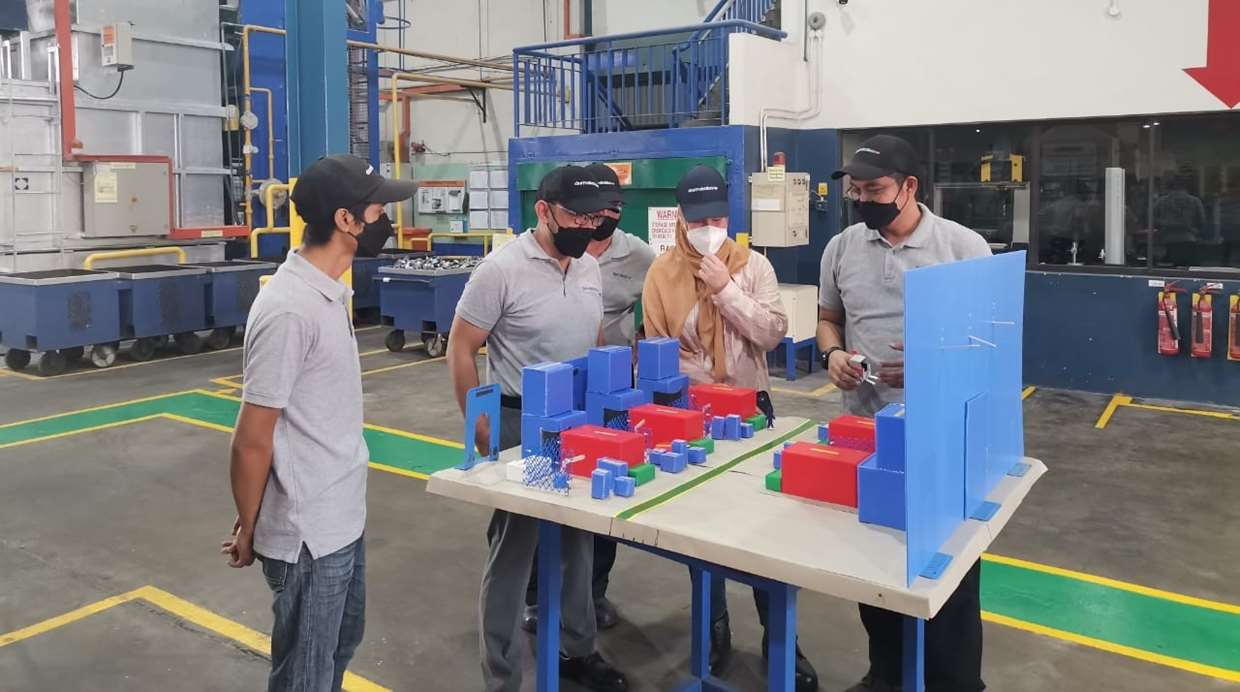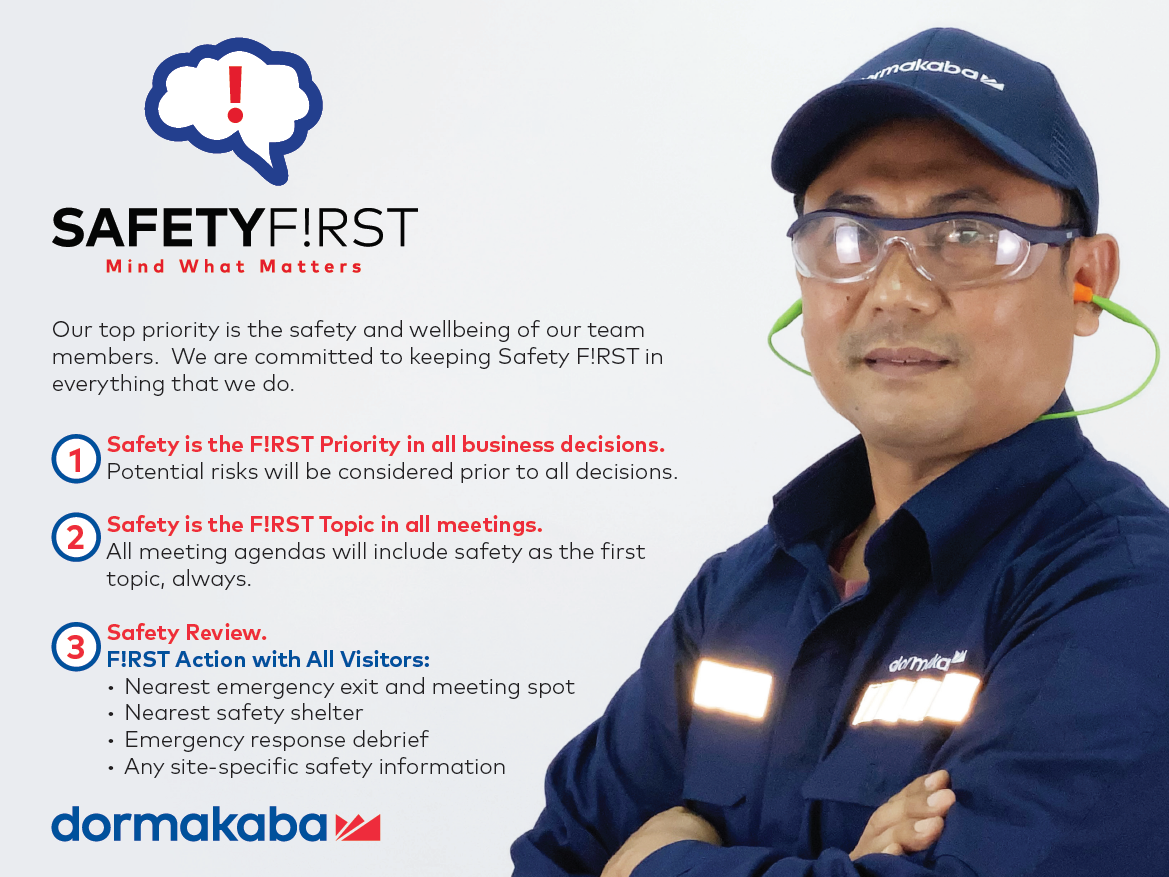Occupational Health & Safety
Throughout our business and most notably at our manufacturing sites worldwide, we respect the human right to safe workplaces. We recognize that in addition to minimizing the incidence of work-related injury and illness, a safe and healthy work environment enhances the quality of products and services, consistency of production, and worker retention and morale.
Our approach
All workers share the human right to safe and healthy working conditions, and as an employer we do our utmost to protect the physical and mental integrity and well-being of our employees. Accidents and work-related illnesses can be of a long-term nature and entail costs to society and the company. We can only be successful in the long term if we help ensure our employees remain healthy. Occupational Health & Safety (OHS) addresses not only the safe operation of machines, ergonomic workplaces, and the handling of hazardous substances, but also mental health issues including stress, depression, and emotional well-being. We strive to simultaneously create optimal working conditions for our employees and to ensure operational efficiency.
In FY 22/23 we have adopted the Group Directive Health & Safety, prepared in collaboration with our Environment, Health & Safety employees. It is based on recognized management systems such as ISO 45001 and the ILO Guidelines on Occupational Health & Safety. The Directive regulates the minimum business standards as regards to occupational health and safety management and processes at local level, such as the safety of the working environments and the health of our employees, contractors, and visitors within our facilities, and of our field service technicians performing their primary duties outside of our facilities. Furthermore, the Directive gives clear guidance on incident data management and on the effective control of facilities and equipment during high-risk activities. The Directive is applicable to all fully consolidated operations of dormakaba worldwide, including those of direct and indirect subsidiaries.
Our activities
Our Group Directive Health & Safety is a foundation for health and safety plans at site level, and 26% of our facilities also have ISO 45001 certification. Despite our efforts to provide a safe workplace, injuries can still occur in and around our facilities, including cuts, stumbles, commuting accidents, burns in smelting operations, injuries due to heavy lifting, or exposure to toxic fumes in galvanization processes. We have been using root cause analysis of injury incidents at our sites around the world to identify and implement the corrective actions necessary to prevent repeated incidents. Our goal is that by the year 2027, we will decrease the recordable work-related injury rate by 33% (baseline 1.4 in FY 20/21).

Promoting a positive safety culture at dormakaba
Katie Henry, Global Lead QHSE at dormakaba, shares her thoughts on the importance of having a proactive safety culture, why it is key in reducing incidents, and some of the most important initiatives of the HSE organization during FY 22/23.
What is a proactive safety culture and why is it so important?
Our numbers prove the theory – sites that have the highest number of unsafe observations have the lowest number of injuries. Because if people see unsafe issues – actions or environments – these can be corrected, and the risk of an incident can be reduced. Our goal is to gain global transparency about proactive safety reporting, so that we can use what we learn from local observations somewhere else too, and act prior to an incident occurring. When we start unlocking this proactive thinking and risk-based analysis at every level of the organization, this can lead to better safety performance.
During FY 22/23 employees submitted 1,261 unsafe observations versus only seven in the previous year. This is true evidence of a positive shift in the safety culture. Which global initiatives would you highlight as contributing to this change?
We launched the SAFETY F!RST initiative this year with the aim of achieving behavioral change and heightened safety awareness at dormakaba. The campaign reminds us that we should always start with safety, whether we are leading a meeting, welcoming visitors, or thinking of our business decisions. Even if it is as simple as reminding people to stay hydrated and take a break when it is too hot, we should always keep safety in our mind. Furthermore, we have implemented an idea from our Singapore site on a global scale and displayed posters with QR codes across our facilities to open the safety reporting opportunity to everyone. Another key action aiming for improved safety performance is that safety performance will be included in the long-term incentives of our senior leadership beginning in the next financial year. Lastly, I would mention that from this year forward, our annual Chief Operations Officer’s Special Award will be based on proactive engagement performance, highlighting the importance of addressing safety hazards before an incident occurs.
In April 2023, the first global Health & Safety Directive was published. Why was it necessary and how will it help the organization?
So far, we have had many local regulatory requirements in place for occupational health and safety across the globe, but this Directive will provide minimum internal standards for our locations. Consequently, it will increase the level of safety management and engagement at many sites, especially at the smaller ones, where the injury rate is usually higher than at our key large manufacturing sites. We have a variety of facilities, ranging from offices, through locations with basic assembly or distribution functions to more complex manufacturing plants. The Directive provides very structured baseline guidance regardless of the type of the facility or the leadership role of the responsible employee.
The Directive is the foundation on which we will develop and continue to improve our health and safety programs, as well as to standardize them. Before it comes into force on 1 July, 2023, we are launching global mandatory trainings for Site Heads and those responsible for implementing the Directive. Furthermore, we are providing them with an Applicability Matrix and other tools, to help them successfully carry out gap and risk assessments.
We have field service technicians working outside of our own facilities, who install or repair our products. What are the key considerations regarding their safety?
Our service employees are working in environments we have the least control over. Therefore, the injury rate tends to be higher among them. What we can influence though are, the mindset and the risk-based thinking of our teammates. Although the Health & Safety Directive includes guidelines for the service teams too, next year we are planning to publish a dedicated service policy and standardized program. There are some local best practices for service safety programs that we are considering expanding to a global level. For example, in the UK we have employees performing audits at the job sites based on the risk assessment that was conducted prior to deployment. Furthermore, trainings and various tools and resources support them to avoid incidents.
To ensure our employees remain safe and healthy, we focus on three areas:
- Health and safety committees
- Employee engagement and training
- Reducing hazardous materials
Health and safety committees
dormakaba employs designated safety personnel and safety committees at several sites. With the implementation of the Health & Safety Directive, each site will have a health and safety committee, including a variety of employees from different departments and shifts, representing a cross-section of the facility operations. Their key responsibility is to ensure that workers comply with the site’s Health and Safety Management Plan and government regulations. Further responsibilities include:
- Reporting unsafe observations and near misses.
- Attending all safety meetings.
- Reviewing injury accidents, illnesses, and investigations.
- Providing ideas and suggestions to improve the health and safety of the facility.
- Promoting safe working practices among all employees.
- Completing or assisting with safety inspections and audits.
- Evaluating the effectiveness of control measures being used to protect employees from workplace hazards.
In order to fulfill these responsibilities, the committee must conduct meetings at least twice a year. During FY 22/23 health and safety committees were set up or reformulated at several sites, including in Lima (Peru), Quebec (Canada), Suzhou (China), Westerstede (Germany), and Greater Noida (India). In Rocky Mount (USA) an evacuation team has also been set up within the safety committee.
Employee engagement and training
Workplace safety trainings are essential to identifying and solving health and safety issues and to protecting our employees. Therefore, each facility must cover the following minimum training topics on a weekly basis as a minimum:
- mechanical, electrical, chemical, fire, and physical hazards,
- the correct use of appropriate personal protective equipment,
- types of potential emergencies that may occur at their work location and what to do during an, emergency, including internal and external meeting points,
- machine safety and the use of safeguards and emergency stops,
- reporting injuries and illnesses.
To identify and address our health and safety risks, employee engagement is crucial. Our employees are encouraged to report challenges and near misses in order to address these risks. This helps employees recognize hazards or unsafe acts and correct them immediately or ask for support to correct the issue. Near miss reports are given the same emphasis and attention as injury reports, and the respective supervisor follows up on the near miss to ensure it is corrected.
During FY 22/23, we launched several health and safety training sessions locally. These included safety awareness trainings for new employees (215 hours) in Greater Noida (India) and ergonomics training on proper lifting techniques for all employees (about 350 people) at the Indianapolis (USA) site. In France, training sessions are assigned to employees based on their job function and the key risks associated with them. The program is aimed at all new hires and provides trainings for employees over three years, on topics such as working at height, safety and electricity, driver safety, and stress management. Since the program was launched in December 2022, more than 230 training sessions have been completed.

Employee well-being
It is important to have a holistic approach to well-being that goes beyond physical health and safety. To foster a healthy workplace, mental health must also be addressed.
Therefore, in FY 22/23 we developed a Well-being Info Hub on our internal website where we continuously upload useful information and training courses – such as tips on how to deal with stress and avoiding burnout – and inspiring initiatives and events from around the world. Furthermore, we added a Well-being at dormakaba community on our internal Yammer platform, where information and announcements connected to health and well-being are posted.
In November 2022, several employees – both men and women – took part in the Movember challenge (moustache + November), raising awareness of men’s mental health and opening up discussion about the typical challenges that they face. We provided informative materials and even members of our top management shared video messages on the topic. In addition to these global initiatives, there have been various activities locally as well, particularly in India, Singapore, and Melaka (Malaysia).

Reducing hazardous materials
Further guidelines on the safe handling, movement, storage, and use of hazardous materials can be found in our Environment Directive.
The potential impact on employees’ health when working with hazardous materials is of special concern, and we seek to eliminate or reduce their use as much as possible. Hazardous materials are used as cooling lubricants, oils in machining, and for the cutting of raw materials. Some hazardous materials are also used to protect other materials from corrosion in electroplating. In accordance with the Group Directive Health & Safety, all facilities that work with such materials must maintain a hazard communication and chemical management program, as well as a transportation compliance policy, if applicable. Our workers responsible for the storage, clean up, or disposal of chemical releases receive specialized training and equipment.
Key activities during FY 22/23 included:
- In Quebec (Canada) at our Skyfold factory, we reduced the use of an acetone-based degreaser, used for panel cleaning containing volatile organic compounds by 60%, by substituting it with a mild dish soap.
- In Rocky Mount (USA), we have continued the evaluation of chemicals used in electroplating to improve quality, as well as to reduce the need to hand mix corrosive chemicals. We substituted a hazardous chemical (acid salt) with sulfuric acid, which has also improved the quality of the product during plating and reduced product scrap.
Our performance
Among all our reporting sites – including offices – 25% have a health and safety management system certified according to ISO 45001, and 63% maintain a health and safety management system. During FY 22/23, Singapore was the latest to achieve ISO 45001 certification and nine employees there also completed ISO 45001 internal auditing training.
In FY 22/23, 210 occupational injury cases were registered, compared to 198 in the previous reporting year. This represents a recordable injury rate of 1.5, the same as in the previous reporting year1. The rate of high-consequence work-related injuries was 0.052. The severity rate was 193. Additionally, seven recordable incidents related to contract or leased workers occurred. Cuts and sprains were the most common types of injuries, and most injuries were sustained to the arms and hands. Most accidents occurred in production plants, with the second-highest number occurring during installation or servicing at customer sites. The most common root cause has been reported as incidents due to technical defects or faulty equipment. Through our global injury incident reporting tool, we have logged the implementation of over 1,500 corrective actions in FY 22/23. The majority of the corrective actions were organizational safety measures, followed closely by technical protective measures.
It is profoundly saddening to report that we were not able to achieve zero fatalities in FY 22/23, resulting in a global fatality rate of 0.014. While eight dormakaba employees were traveling home from their shift at the plant in Singapore, a tragic car accident occurred. One colleague was killed in the accident, with six others hospitalized for medical treatment. The safety of our employees is our top priority, and we will continue to increase our efforts to keep everyone safe at dormakaba.
Outlook
Besides the roll-out of the Group Directive Health & Safety, our focus in FY 23/24 will be the development of an additional health and safety directive, specifically addressing our service business and employees. We will also be implementing a new Health & Safety incident reporting tool, which will allow for increased transparency for global read across, and mobile accessibility for immediate reporting of unsafe observations and near misses. It will also be able to send automated notifications to the responsible leadership and provide connectivity to BI applications for further analysis of trends in order to target deficiencies in the safety management system at a local, regional, and global level.
Under the direct lead of the Global Lead QHSE, we will conduct trainings specifically for sub-contractors. This activity is also part of the corrective action plan following the tragic accident in Singapore.